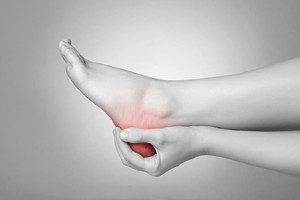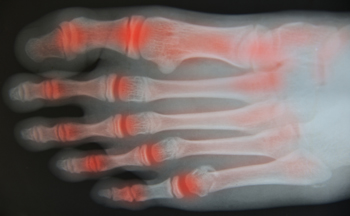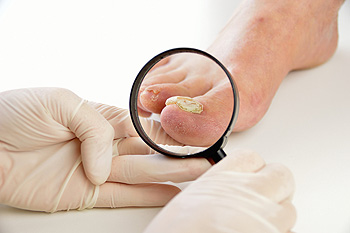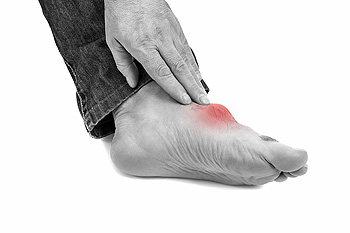January 2021
How Toenail Fungus May Be Treated
A fungal infection that affects the nail bed is referred to as toenail fungus. It affects many people worldwide, and may appear unsightly. The medical term for this condition as onychomycosis, and can cause the nails to become yellowed, thickened, and brittle. The fungi that causes this ailment lives and thrives in warm and moist environments. These environments include shower room floors, public swimming pools, and surrounding areas. Some patients find success in treating this disorder with oral or topical medications, or having laser surgery performed. If you are affected with toenail fungus, please confer with a podiatrist who can offer correct treatment options.
For more information about treatment, contact Dr. Lee R. Stein of Lake Shore Foot & Ankle, PC. Our doctor can provide the care you need to keep you pain-free and on your feet.
Toenail Fungus Treatment
Toenail fungus is a condition that affects many people and can be especially hard to get rid of. Fortunately, there are several methods to go about treating and avoiding it.
Antifungals & Deterrence
Oral antifungal medicine has been shown to be effective in many cases. It is important to consult with a podiatrist to determine the proper regiment for you, or potentially explore other options.
Applying foot powder on the feet and shoes helps keep the feet free of moisture and sweat.
Sandals or open toed shoes – Wearing these will allow air movement and help keep feet dry. They also expose your feet to light, which fungus cannot tolerate. Socks with moisture wicking material also help as well.
If you have any questions please feel free to contact one of our offices located in Chicago, Highland Park, and Uptown, IL . We offer the newest diagnostic tools and technology to treat your foot and ankle needs.
Plantar Fascia Injections
 Plantar fasciitis is an inflammation of the plantar fascia, the ligament that runs along the bottom of the foot connecting the heel bone to the toes. This condition can cause pain on the inside of the bottom of the heel, and it is often the result of overuse injuries from activities that put repetitive stress on the foot, such as running or jogging. Typical treatments for plantar fasciitis can include resting and icing the affected foot, wearing orthotic devices in the shoes, and taking anti-inflammatory drugs. In some cases, these treatments may be ineffective and other options can be explored. One other potential treatment for plantar fasciitis is an injection of a corticosteroid into the plantar fascia. This can reduce inflammation and relieve pain for a longer period of time than more conservative measures. If you are experiencing heel pain, it is suggested that you see a podiatrist for treatment.
Plantar fasciitis is an inflammation of the plantar fascia, the ligament that runs along the bottom of the foot connecting the heel bone to the toes. This condition can cause pain on the inside of the bottom of the heel, and it is often the result of overuse injuries from activities that put repetitive stress on the foot, such as running or jogging. Typical treatments for plantar fasciitis can include resting and icing the affected foot, wearing orthotic devices in the shoes, and taking anti-inflammatory drugs. In some cases, these treatments may be ineffective and other options can be explored. One other potential treatment for plantar fasciitis is an injection of a corticosteroid into the plantar fascia. This can reduce inflammation and relieve pain for a longer period of time than more conservative measures. If you are experiencing heel pain, it is suggested that you see a podiatrist for treatment.
Plantar fasciitis can be very painful and inconvenient. If you are experiencing heel pain or symptoms of plantar fasciitis, contact Dr. Lee R. Stein from Lake Shore Foot & Ankle, PC. Our doctor can provide the care you need to keep you pain-free and on your feet.
What Is Plantar Fasciitis?
Plantar fasciitis is the inflammation of the thick band of tissue that runs along the bottom of your foot, known as the plantar fascia, and causes mild to severe heel pain.
What Causes Plantar Fasciitis?
- Excessive running
- Non-supportive shoes
- Overpronation
- Repeated stretching and tearing of the plantar fascia
How Can It Be Treated?
- Conservative measures – anti-inflammatories, ice packs, stretching exercises, physical therapy, orthotic devices
- Shockwave therapy – sound waves are sent to the affected area to facilitate healing and are usually used for chronic cases of plantar fasciitis
- Surgery – usually only used as a last resort when all else fails. The plantar fascia can be surgically detached from the heel
While very treatable, plantar fasciitis is definitely not something that should be ignored. Especially in severe cases, speaking to your doctor right away is highly recommended to avoid complications and severe heel pain. Your podiatrist can work with you to provide the appropriate treatment options tailored to your condition.
If you have any questions please feel free to contact one of our offices located in Chicago, Highland Park, and Uptown, IL . We offer the newest diagnostic and treatment technologies for all your foot and ankle needs.
It's Time for Beautiful Feet
Weight and the Joints of the Feet
 Osteoarthritis is a condition that causes the lining of the joints to break down over time. This type of arthritis frequently affects the small joints of the feet and ankles. One of the factors that can increase your risk of developing osteoarthritis and joint pain is being overweight or obese. Because the joints of the lower limbs bear the weight of the entire body, they can become increasingly damaged from carrying excess weight. Losing weight may help prevent osteoarthritis in those who do not yet have it and can reduce the severity of arthritis symptoms and prevent further damage in those who do. If you have osteoarthritis in your feet or ankles, a podiatrist can help you manage this condition.
Osteoarthritis is a condition that causes the lining of the joints to break down over time. This type of arthritis frequently affects the small joints of the feet and ankles. One of the factors that can increase your risk of developing osteoarthritis and joint pain is being overweight or obese. Because the joints of the lower limbs bear the weight of the entire body, they can become increasingly damaged from carrying excess weight. Losing weight may help prevent osteoarthritis in those who do not yet have it and can reduce the severity of arthritis symptoms and prevent further damage in those who do. If you have osteoarthritis in your feet or ankles, a podiatrist can help you manage this condition.
The more you weigh, the harder your feet must work to support your body. If you’re an obese individual and are concerned about your feet, contact Dr. Lee R. Stein from Lake Shore Foot & Ankle, PC. Our doctor can provide the care you need to keep you pain-free and on your feet.
Obesity and Your Feet
People who are overweight are putting more pressure on their ankles, knees, and hips as well as their feet. This unfortunately can lead to variety of different issues.
Problems & Complications Stemming from Obesity
- When the body is overweight, it tries to compensate by changing the way that it moves. An obese person may lean forward and put extra weight on the wrong part of the foot. This puts unnecessary stress on the feet.
- Obese people are also more likely to develop type II diabetes which is a condition that causes a lot of foot problems. People with diabetes often don’t feel the cuts and sores that they may have on their feet, which can lead to more complicated and severe issues.
- Plantar fasciitis is another foot condition that can be caused by obesity. Plantar fasciitis is an inflammation of the tissue along the bottom of the foot, which causes pain and stiffness while walking and climbing stairs.
If you have any questions, please feel free to contact one of our offices located in Chicago, Highland Park, and Uptown, IL . We offer the newest diagnostic and treatment technologies for all your foot care needs.
Staying Active With Gout
Gout can be painful and disruptive to your daily activities. If you are an avid exerciser, you may worry if gout will get in the way. However, unless you are in the middle of an active flare up, you should still be able to exercise. Generally, regular exercise can mitigate the symptoms of gout by helping you maintain a healthy weight, which reduces pressure on the joints, and by lowering the levels of uric acid in your blood. However, during a gout flare up, it is best to rest, as gout flare ups tend to be extremely painful. Resting keeps excess pressure off of the joints in your feet, which can reduce inflammation and pain. After a gout flare up, it is suggested that you ease back into exercising slowly by doing aquatic or low impact exercises and stretching. For more information about managing gout, please consult with a podiatrist.
Gout is a foot condition that requires certain treatment and care. If you are seeking treatment, contact Dr. Lee R. Stein from Lake Shore Foot & Ankle, PC. Our doctor will treat your foot and ankle needs.
What Is Gout?
Gout is a type of arthritis caused by a buildup of uric acid in the bloodstream. It often develops in the foot, especially the big toe area, although it can manifest in other parts of the body as well. Gout can make walking and standing very painful and is especially common in diabetics and the obese.
People typically get gout because of a poor diet. Genetic predisposition is also a factor. The children of parents who have had gout frequently have a chance of developing it themselves.
Gout can easily be identified by redness and inflammation of the big toe and the surrounding areas of the foot. Other symptoms include extreme fatigue, joint pain, and running high fevers. Sometimes corticosteroid drugs can be prescribed to treat gout, but the best way to combat this disease is to get more exercise and eat a better diet.
If you have any questions please feel free to contact one of our offices located in Chicago, Highland Park, and Uptown, IL . We offer the newest diagnostic and treatment technologies for all your foot and ankle needs.
Blog Archives
- April 2025
- March 2025
- February 2025
- January 2025
- December 2024
- November 2024
- October 2024
- September 2024
- August 2024
- July 2024
- June 2024
- May 2024
- April 2024
- March 2024
- February 2024
- January 2024
- December 2023
- November 2023
- October 2023
- September 2023
- August 2023
- July 2023
- June 2023
- May 2023
- April 2023
- March 2023
- February 2023
- January 2023
- December 2022
- November 2022
- October 2022
- September 2022
- August 2022
- July 2022
- June 2022
- May 2022
- April 2022
- March 2022
- February 2022
- January 2022
- December 2021
- November 2021
- October 2021
- September 2021
- August 2021
- July 2021
- June 2021
- May 2021
- April 2021
- March 2021
- February 2021
- January 2021
- December 2020
- November 2020
- October 2020
- September 2020
- August 2020
- July 2020
- June 2020
- May 2020
- April 2020
- March 2020
- February 2020
- January 2020
- December 2019
- November 2019
- October 2019
- September 2019
- August 2019
- July 2019
- June 2019
- May 2019
- April 2019
- March 2019
- February 2019
- January 2019
- December 2018
- November 2018
- October 2018
- September 2018
- August 2018
- July 2018










